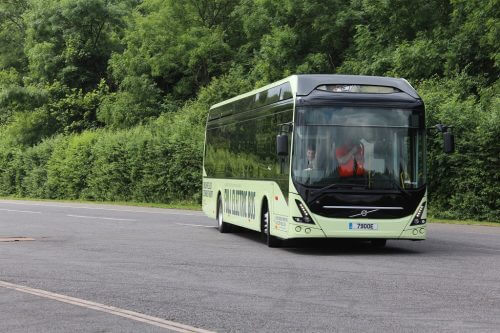
Last week at Donington Park in Derbyshire, the right hand drive Volvo electric bus (7900e) was launched and Jade Smith was there to see the vehicle in action, along with others from the Electromobility range
Volvo Bus marked the arrival of its first right hand drive, full 7900e electric bus in the UK which is the latest addition to the Volvo Bus Electromobility range, at a special ride and drive event last week at Donington Park in Derbyshire. Those attending were able to see and ride on a selection of Volvo buses and coaches, and also had the opportunity to test drive the vehicles.
After a brief welcome speech, the event kicked off with the revealing of the Volvo electric bus (7900e) featuring musicians on electric violins playing Eddy Grant’s ‘Electric Avenue’. It set the theme for the day: Volvo’s offering of an electrified future to improve cities.
Following the event, the Volvo 7900e will be embarking on a UK demonstration programme during the remainder of 2017 and into 2018. The Volvo 7900e will be making its operational debut during 2018 with Transdev Blazefield, when eight vehicles will be entering service in Harrogate.
Speaking at the event, Nick Page, Managing Director of Volvo Bus, said: “We are naturally very excited to have the first right hand drive 7900e arrive in the UK and it has been great to have the opportunity to showcase this latest addition to our Electromobility range here today to our guests.
“The Electric Avenue event was conceived to highlight and discuss with customers and stakeholders, some of the challenges that our society is facing in relation to public transport. These include factors such as our current approach to urban planning, the environment and noise pollution, and how the Volvo Electromobility range can play a key role in meeting these challenges.
“At the event we have focused on five key messages which centre around the delivery of emission-free environments, that are quiet and provide world class safe transport for the people who live and work in urban areas. We have also looked at the new urban planning possibilities that electrified vehicles can create, while showcasing the proven technology that Electromobility can and will deliver now and in the future.”
The five key questions Volvo posed at the event were:
- Do you want an emission-free city?
- Are you dreaming of a quiet life?
- Do you demand world-class safety?
- What can your city be?
- Do you need proven technology?
Delegates were driven around the Electric Avenue on the Donington Park test track on-board the Volvo electric bus (7900e), calling at five ‘stations’ where short presentations were made on each element. […]
What you get with a subscription
- Operator & Supplier Profiles
- Face-to-Face Interviews
- Lastest News
- Test Drives and Reviews
- Legal Updates
- Route Focus
- Industry Insider Opinions
- Passenger Perspective
- Vehicle Launches
- and much more!


